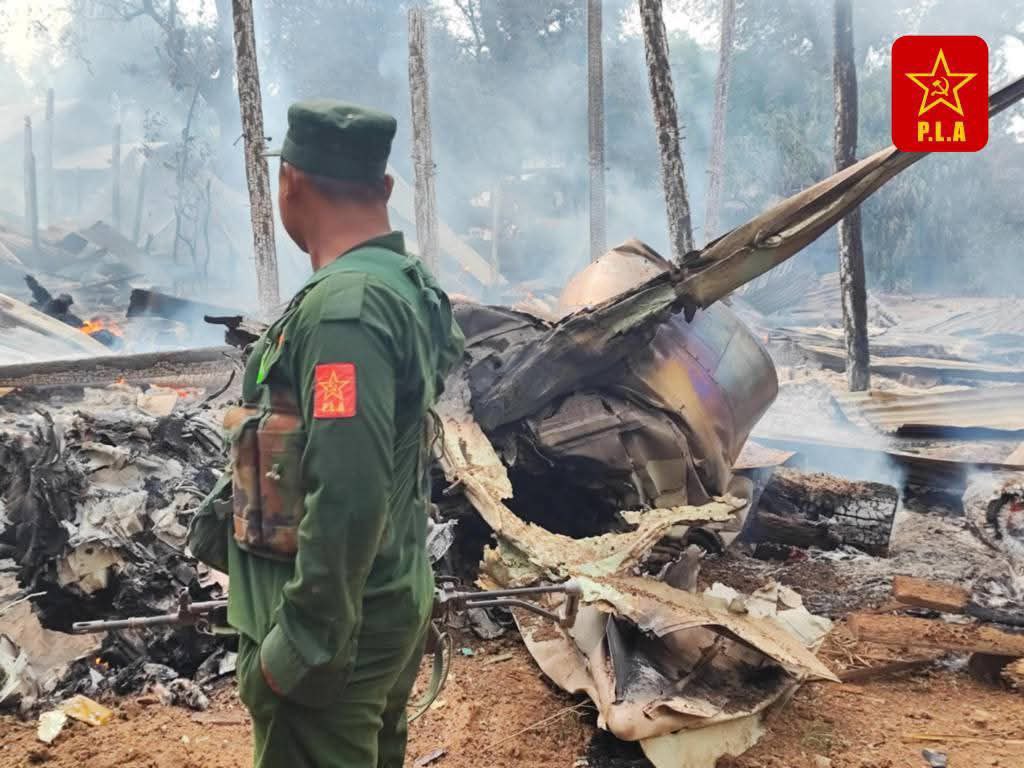Correction: Analysis of social media images of the crash site by the Britain-based Centre for Information Resilience’s Myanmar Witness project identified the jet as a Chinese-manufactured single-seat Chengdu F-7.
Earlier Report
A Myanmar Air Force fighter jet, most likely JF-17, crashed in Pale Township, located in the conflict-ridden Sagaing Region. The aircraft could not be identified properly, and some reports suggest that it could be a Chinese-built FTC-2000G, a light fighter and ground-attack aircraft.
Myanmar anti-coup guerrillas claimed to shoot down a junta jet, declaring a rare victory over the air force, which has kept them at bay in a grinding civil war.
The military swiftly denied their claim, saying the plane crashed near the central village of Min Taing Pin around midday because of “sudden engine failure” while on a “practice flight”.
Myanmar has been consumed by civil war since the military ousted a democratic government in 2021. Still, analysts say its air force, backed by Russia and China, has allowed it to fend off a myriad of lesser-equipped opposition groups.
The military and some of its adversaries have pledged a truce this month as the country continues to recover from March’s devastating magnitude-7.7 earthquake, which killed nearly 3,800 people.

But the People’s Liberation Army (PLA) — the armed wing of a Myanmar communist group — said its fighters downed the plane after four days of fierce conflict in central Sagaing region, one of the areas worst-hit by the quake.
“Our fighters were able to shoot down an attack jet today. This is a first in the history of the PLA,” said a spokeswoman.
🚨🚨Another JF-17 Thunder GOES DOWN!
Earlier, Pakistan was believed to have lost three JF-17 fighters in its recent clash with India.
The jets were reportedly eliminated via BVR missile engagements and stand-off munitions strikes near Jacobabad.
Now, a JF-17 fighter jet… pic.twitter.com/CYQ6esMDL3
— EurAsian Times (@THEEURASIATIMES) June 11, 2025
Zaw Tun, a member of the local anti-coup People’s Defence Force, said they were fighting alongside the PLA when “our joint forces used machine guns and shot it down”.
A local administrator from the rebel-held area, Zaw Htet, said two planes were returning from a bombing run when one was hit as both “flew very low on the way back”.
Images on social media showed opposition fighters travelling towards a flaming wreck in an area littered with metal debris, including what appeared to be a piece of landing gear.
However, the junta’s information team stated that its security forces had seized the crash site and that “relevant authorities are continuing investigation of the cause of the engine failure.”
While junta jets have kept opposition forces largely confined to Myanmar’s fringes, they have also been accused of striking civilian targets with impunity.
JF-17 THUNDER
The JF-17 Thunder is a lightweight, single-engine, multirole combat aircraft developed jointly by the Pakistan Aeronautical Complex (PAC) and China’s Chengdu Aircraft Corporation (CAC).
Marketed as a cost-effective alternative to Western aircraft, the JF-17 promised versatility for interception, ground attack, and aerial reconnaissance missions. However, Myanmar’s experience with the aircraft has been fraught with challenges.
Myanmar became the first export customer for the JF-17, signing a $560 million deal for 16 Block II variants to replace its aging fleet of Chinese-made Nanchang A-5 and Chengdu F-7 aircraft.
The first batch of seven JF-17s, including five single-seat JF-17As and two dual-seat JF-17Bs, was delivered by 2018 and officially commissioned during ceremonies at Meiktila Air Base. The MAF initially showcased the aircraft in fly-bys and displays, signaling a modernization of its air capabilities amid ongoing insurgencies and regional tensions.
However, optimism quickly faded. By 2022, reports emerged that most of Myanmar’s JF-17 fleet—up to 11 aircraft—had been grounded due to persistent technical issues.
Analysts and former MAF pilots cited structural cracks in the airframe, particularly at the wingtips and hardpoints, as well as malfunctions in critical systems, such as the Chinese-made KLJ-7 AI radar, which suffered from poor accuracy and maintenance issues.
The Weapon Mission Management Computer also failed to deliver effective beyond-visual-range (BVR) missile capabilities, limiting combat performance. Compounding these issues, Western sanctions following Myanmar’s 2021 military coup disrupted the supply of spare parts for the aircraft’s Western-sourced avionics, leaving the MAF without the technical expertise to address the problems.
Frustrated, junta leader General Min Aung Hlaing reportedly expressed strong dissatisfaction to Pakistani officials, straining bilateral ties.
Pakistan sent technical teams to Myanmar in 2022 and 2023 to address the issues, and discussions were held about supplying newer JF-17 variants; however, these efforts yielded limited success. China, a co-developer of the aircraft, also intervened diplomatically, though the outcome remains unclear.
The MAF’s struggles with the JF-17 have not only impacted its operational readiness but also damaged the aircraft’s reputation in the global export market, with countries like Nigeria reporting similar technical concerns.
Earlier, as EurAsian Times reported, Pakistan is believed to have lost three JF-17 fighters in its recent clash with India. The jets were reportedly eliminated via BVR missile engagements and stand-off munitions strikes near Jacobabad.
With AFP Inputs





